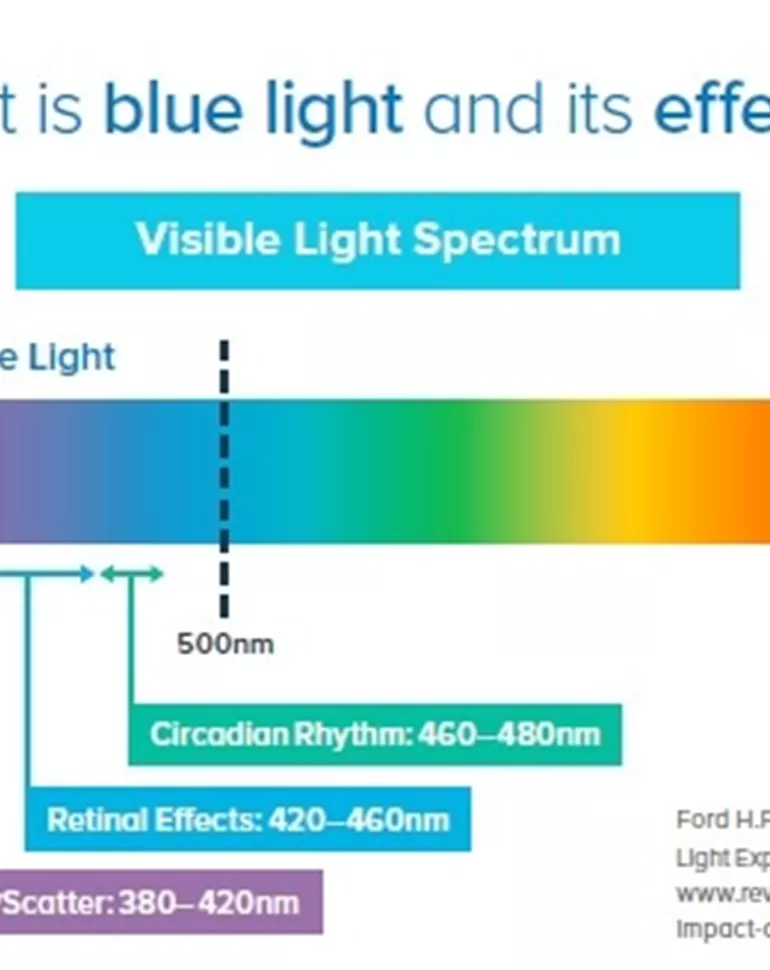What Is Blue Light?
Visible light consists of a spectrum of individual light rays, each with its own color and energy level.
This energy is determined by the wavelength of the individual light rays. The shorter the wavelength, the more energy a specific light ray has, and vice versa. Wavelengths are specified in tiny units of length called nanometers (nm).
Blue light is that portion of the visible light spectrum that has more energy than any other rays of visible light. In fact, the highest energy (shortest wavelength) blue light rays have nearly as much energy as invisible UV rays that have been shown to be damaging to the eyes.
Blue light encompasses wavelengths ranging from 380 nm (highest energy) to 500 nm (lowest energy). The entire visible light spectrum comprises wavelengths ranging from 380 nm to 780 nm.
Read more about what we know — and don’t know — about blue light.
The Bad News About Blue Light
Blue light (like all types of visible light) can penetrate deeper into the eye than invisible UV rays.
In other words, the cornea and lens of the eye are exposed to UV, but these rays pretty much stop there. Blue light, on the other hand, can pass through both the cornea and lens and reach the light-sensitive retina in the back of the eye.
Because of its high energy and ability to penetrate deep into the eye, blue light has the potential to cause unwanted changes in the retina over time. In fact, some researchers believe too much exposure to blue light over the course of a person's lifetime may increase the risk of sight-robbing conditions like macular degeneration.
In particular, light on the high-energy end of the blue light spectrum —ranging from 380 nm to 460 nm (sometimes referred to as "violet-blue" light) — appears to have the greatest potential for causing retina damage.
Also, not all wavelengths of visible light come to a perfect focus inside the eye. In particular, short-wavelength blue light tends to be slightly defocused compared with other visible light. This can create a violet-blue "blur circle" that contributes to a phenomenon called chromatic aberration.
Chromatic aberration especially affects visual quality and comfort when viewing print on computer screens and other digital displays, and is believed to be a factor in eye strain that's common among users of these devices. In fact, according to the 2017 Digital Eye Strain Report published by The Vision Council, nearly one third (32.6 percent) of people who use computers, e-tablets, smart phones and other digital devices complain of eye strain, and the risk of this discomfort increases with the number of hours spent using these devices throughout the day.
One thing is undeniable: people are exposed to significantly more blue light these days than ever before. An addition to being emitted by sunlight (the most significant source of blue light by far), computers and other digital devices, these potentially harmful high-energy visible rays also are emitted by modern LED light bulbs and other high-efficiency indoor lighting.
And it's unclear at this time how much increased risk of developing macular degeneration and other potential eye damage people are being subjected to from this increased exposure.
Looking for ways to recommend blue light filtration to your patients?
The Good News About Blue Light
Now here's where things get tricky...
Some blue light —particularly visible rays on the lower-energy end of the blue light spectrum — actually is good for you!
The proper amount and timing of exposure to blue light with wavelengths ranging from 460 nm to 500 nm is very important for regulating our biological clock (circadian rhythm) which influences our sleep/wake cycle and general well-being.
Exposure to this lower-energy blue light during the day releases hormones that help us feel alert and focused. But too much exposure to these rays later in the evening can suppress hormones that help us achieve restful sleep — resulting in drowsiness and lack of focus during the following day from blue light-induced sleep disturbances.
What To Do
Protecting eyes from too much blue light exposure is fast becoming one of the hottest topics in vision care. This is particularly true when it comes to children's eyes, because younger generations will certainly have more exposure to blue light in their lifetime than today's adults.
To fully understand the risks and benefits of blue light and how to adequately protect your eyes (and your children's eyes) from light-induced damage, schedule a vision exam with your eye doctor.
During your exam, discuss your lifestyle — including how much of your day is spent outdoors, in front of a computer screen and other digital displays, and how late into the evening you typically use digital devices.
Also, bring your sunglasses with you to your exam so your doctor can take a look at them and determine if they provide adequate UV and blue light protection outdoors.
Your eye doctor can then discuss with you the most prudent measures to take, which may include wearing eyeglasses that filter blue light.
